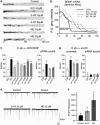Physical exercise and antidepressants enhance BDNF targeting in hippocampal CA3 dendrites: further evidence of a spatial code for BDNF splice variants
- PMID: 22318196
- PMCID: PMC3358751
- DOI: 10.1038/npp.2012.5
Physical exercise and antidepressants enhance BDNF targeting in hippocampal CA3 dendrites: further evidence of a spatial code for BDNF splice variants
Abstract
Brain-derived neurotrophic factor (BDNF) is encoded by multiple BDNF transcripts, whose function is unclear. We recently showed that a subset of BDNF transcripts can traffic into distal dendrites in response to electrical activity, while others are segregated into the somatoproximal domains. Physical exercise and antidepressant treatments exert their beneficial effects through upregulation of BDNF, which is required to support survival and differentiation of newborn dentate gyrus (DG) neurons. While these DG processes are required for the antidepressant effect, a role for CA1 in antidepressant action has been excluded, and the effect on CA3 neurons remains unclear. Here, we show for the first time that physical exercise and antidepressants induce local increase of BDNF in CA3. Voluntary physical exercise for 28 consecutive days, or 2-week treatment with 10 mg/kg per day fluoxetine or reboxetine, produced a global increase of BDNF mRNA and protein in the neuronal somata of the whole hippocampus and a specific increase of BDNF in dendrites of CA3 neurons. This increase was accounted for by BDNF exon 6 variant. In cultured hippocampal neurons, application of serotonin or norepinephrine (10-50 μM) induced increase in synaptic transmission and targeting of BDNF mRNA in dendrites. The increased expression of BDNF in CA3 dendrites following antidepressants or exercise further supports the neurotrophin hypothesis of antidepressants action and confirms that the differential subcellular localization of BDNF mRNA splice variants provides a spatial code for a selective expression of BDNF in specific subcellular districts. This selective expression may be exploited to design more specific antidepressants.
Figures







References
-
- Aliaga EE, Mendoza I, Tapia-Arancibia L. Distinct subcellular localization of BDNF transcripts in cultured hypothalamic neurons and modification by neuronal activation. J Neural Transm. 2009;116:23–32. - PubMed
Publication types
MeSH terms
Substances
LinkOut - more resources
Full Text Sources
Medical
Miscellaneous

